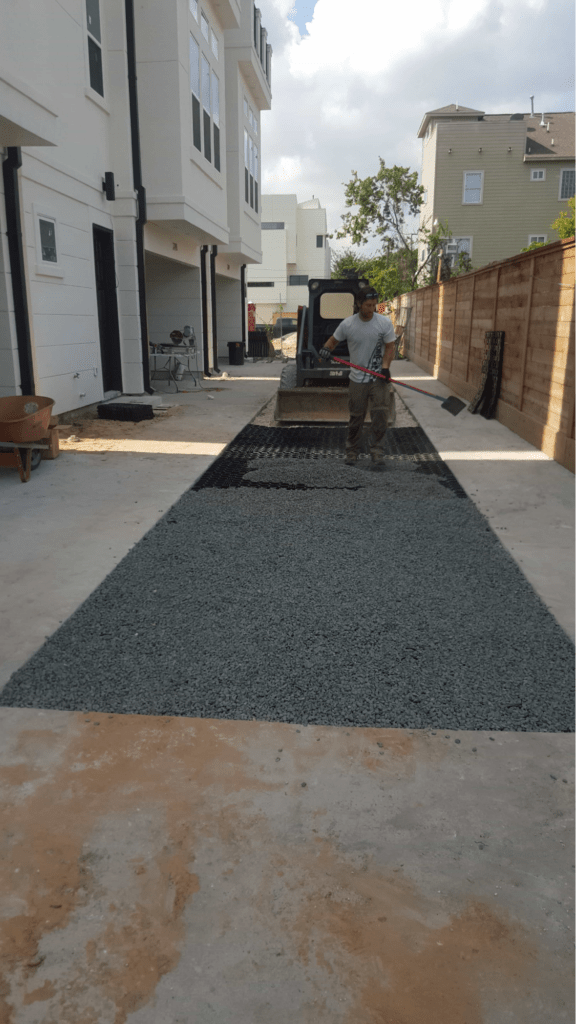
Potholes in gravel are a huge problem for many people. Because of the nature of loose gravel, potholes develop frequently in roads, driveways, walkways, and other areas paved with loose gravel.
When a pothole in gravel develops, it can lead to a wide variety of issues that can cause annoyance, injury, and damage to vehicles, if left untreated. Potholes in gravel will also get bigger and bigger over time if they aren’t dealt with. For these reasons, it’s imperative that you address any potholes you find in gravel pavement as soon as possible.
There are many ways to treat a pothole in gravel, but not all of them are as practical as one another. Concrete, for example, is a common material used to fill in potholes. On the surface, it might seem like a smart, semi-permanent solution to a pothole in gravel pavement, but there are many reasons why this is not the case.
If you want to learn about the best way to fill potholes in gravel, let’s take a look at a few different materials that are available, as well as what the best material is for permanent pothole filling.
Material Choices for Filling Potholes
1. Concrete
Concrete is a popular choice when it comes to filling potholes because, unlike gravel, concrete is much more permanent and less likely to break down. Gravel can spread, but concrete, obviously cannot. However, filling gravel potholes with concrete isn’t as foolproof as it sounds for a number of reasons.
For starters, concrete has vulnerabilities of its own. It needs to be resealed every 5 years or else water will penetrate its surface and cause cracks to develop and get bigger over time. Concrete is also brittle in cold temps, and subject to chipping and cracking. Concrete is also impermeable, meaning it will create runoff around the edges which will lead to an increased level of erosion.
In short, unless you replace the entire paved surface with concrete, you’re going to get a higher level of erosion and degradation all around the edges of the original pothole. Concrete also costs a lot to install if you aren’t doing the job yourself, and it takes a long time to install compared to other materials.
2. Loose Gravel
Loose gravel is the cheapest and easiest way to fill a pothole. Unlike filling gravel potholes with concrete, loose gravel is super quick and cheap. The downside, however, is that you have to keep adding more gravel to your paved area as it breaks down and spreads off to the sides. Gravel spreads and breaks down rather quickly, meaning you have to constantly buy more gravel and add it to your paved area.
3. Asphalt
Using asphalt to fill a pothole is similar to filling potholes with concrete. It’s longer-lasting than loose gravel, but needs to be resealed every 5 years to prevent water intrusion. Asphalt is also vulnerable in hot temps because it becomes sticky. It costs about the same as concrete to buy and install, and takes almost as long.
It’s impermeable as well, meaning it will cause runoff all around its edges which will require you to add more and more material to fill in these gaps in the gravel. There are permeable versions of both asphalt and concrete you can implement, but they are generally much more fragile than the regular, impermeable versions. Thus, it will drive up the long-term cost of maintenance significantly.
4. Permeable Pavers

Permeable pavers are by far the best choice for filling gravel potholes. Unlike filling gravel potholes with concrete, permeable pavers are much more durable, cost-effective, and permeable. TRUEGRID PRO LITE and TRUEGRID PRO PLUS pavers, for example, have 100% permeability. This allows them to drain even the heaviest levels of rain directly through them and into the soil below before it can cause any flooding or erosion.
They’re also much easier and quicker to install gravel or concrete, with installation able to be completed in less than a day in most cases. They will never shift, sink, crack, or warp. The inability to shift or sink comes from the fact that they are installed over a sub-base of gravel, to prevent movement.

TRUEGRID pavers are also made from 100%-recycled plastic, making them the most eco-friendly choice for repairing gravel potholes, by far. TRUEGRID pavers will last up to 60 years before needing to be replaced and require almost zero maintenance throughout their lifetime.

TRUEGRID pavers are durable enough to handle any type of vehicle traffic at any level of frequency. They can even withstand the weight of a monster truck driving off a ramp and landing on them without breaking, and that’s before they’re even filled with gravel. The surface of the pavers is filled with gravel that is compressed into their empty cells and locked into place, to prevent migration or degradation from occurring.
TRUEGRID Pavers Are the Smartest Choice for Filling Gravel Potholes

If you want the most cost-effective, durable, permeable, long-lasting, easy-to-maintain, and quickest alternative to filling gravel potholes with concrete, don’t hesitate to contact TRUEGRID today to get in touch with a pavement specialist who can get you pointed in the right direction.



